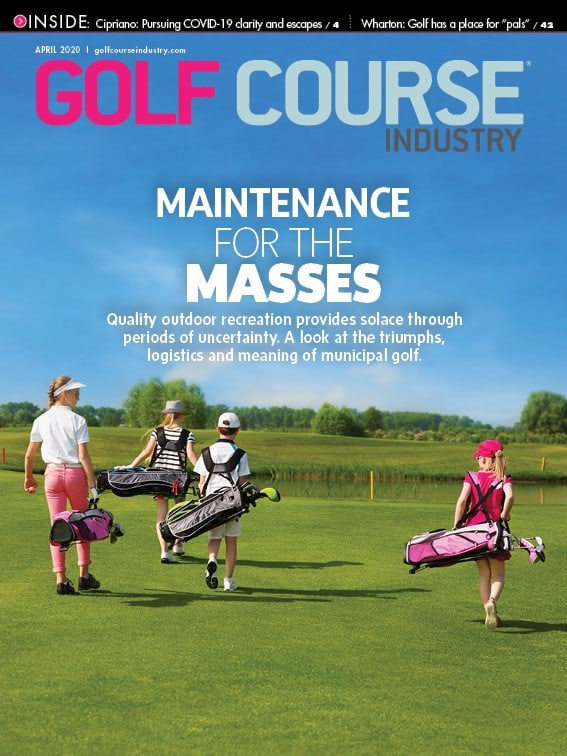
Like a lot of folks in the golf industry, I grew up in municipal golf. This was New York City in the 1960s, back in the days when the conditions presented to everyday golfers were anything but pristine. Just to get to Kissena Park in the center of Queens was a journey of its own – two bus rides and a half-mile walk with my golf bag over the Long Island Expressway, up a hill, to a classic beat-up layout where I learned that, in order to get my tee into the ground, I needed to include a little water bottle and hammer in my golf bag because the tees were nothing but hard-packed dirt.
We played high school matches on a succession of courses in that borough. Along with Kissena, there were Forest Park, Douglaston and Clearview. We didn’t worry about Stimpmeter speeds or complain about the greens being too small, too bumpy or inconsistent with original design intent. We were just thankful for a place to play.
Fast forward a full half century and the whole culture and concern about golf is entirely different. Back then there were no chances to chat about golf courses on social media; no painstaking dissection of golf holes, course conditions or calls for tree management and restoration. Nor did management of municipal courses back then extend beyond anything but a basic model of Parks and Recreation Department oversight.
The term “oversight” is an apt one because the contradictory ambivalence of the term fully expresses how seriously golf was taken within the government’s portfolio. Parks Departments “oversaw” the golf, but they did so by virtue of an “oversight” – by neglect.
We’ve seen a resurgence of municipal golf of late, following successful major championships at municipal facilities on both coasts and increased attention in major golf publications and websites. Such attention is needed in an era of major public budget cutbacks, tax shortfalls and agonizing debates about how to maintain public services. Those concerns are likely to be exacerbated in the wake of the recent Coronavirus-mandated temporary shutdowns of golf courses across the country.
What can be done to protect this treasured sector of the golf environment? Here are seven basic steps to undertake:
- Do not treat golf operations as just another municipal function. Respect its distinctiveness and place its operation within an arm of the Parks and Recreation Department. Better yet, create a quasi-independent Enterprise Fund so that golf revenues and expenses are treated as a self-contained entity rather than as a feeder – or drain – from the public budget.
- While a strong case can be made for seeking independent, private-sector management of the operation, always preserve a measure of public input and control through a golf committee, working with the management firm. Do not be afraid to write specifications into the management contract such as mandating a certain rate structure and maintenance standards.
- In searching for a management company, do not rely upon “lowest-bidder” standard of selection. Issue a detailed Request for Qualifications instead of (or before) going to a standard Request for Proposals in order to weed out inexperienced or financially challenged potential bidders.
- Create incentives in the management contract for performance – such as bonus fees for exceeding a certain level of revenue above operating expenses.
- Carefully document the condition of the golf operation and of course maintenance and equipment upon the start date of the management contract. Get it in written, photographic and video form. Use that as a baseline for periodic review of performance. Use third-party consultants to provide an objective assessment beyond the management firm’s own internal agronomic expertise when it comes to the start and end of a contract.
- Don’t just hand over operations to a management firm. Whether the arrangement entails a lease or monthly/annual fee by an operator, create a mechanism of consultation and input through a citizen committee or town council sub-committee to meet periodically and review performance and provide citizen input.
- Finally, don’t try to compete with private clubs in terms of service, conditioning or extent of facilities. They meet the needs of a certain sector of the golf world. So does the municipal sector. Don’t mistake that role by trying to be all things to all people.

Explore the April 2020 Issue
Check out more from this issue and find your next story to read.
Latest from Golf Course Industry
- Audubon International announces newest leadership appointees
- Southern golf trifecta
- Sports for Nature Framework gains new signatories
- Camiral Golf & Wellness upgrades Stadium Course
- Troon selected to manage The University Club of Milwaukee
- Kafka Granite adds new business development manager
- GCSAA celebrates 10-year anniversary of collaboration with Congress
- DLF launches new seed enhancement solution





